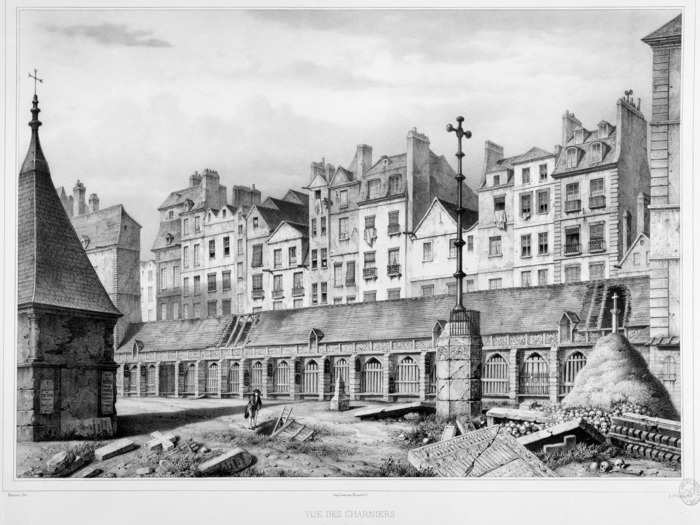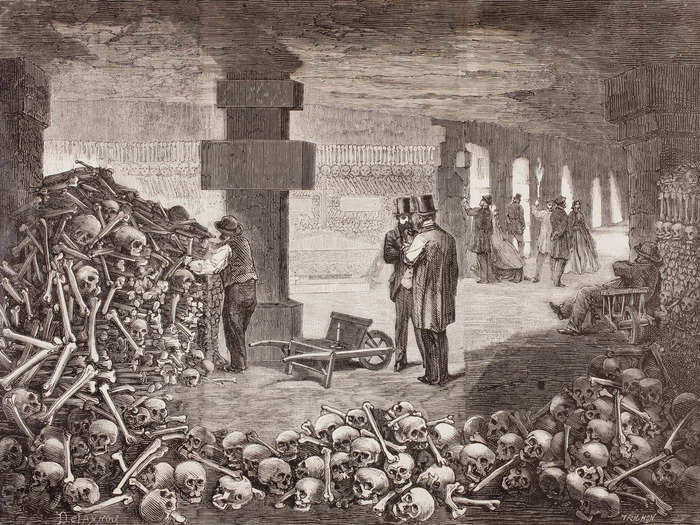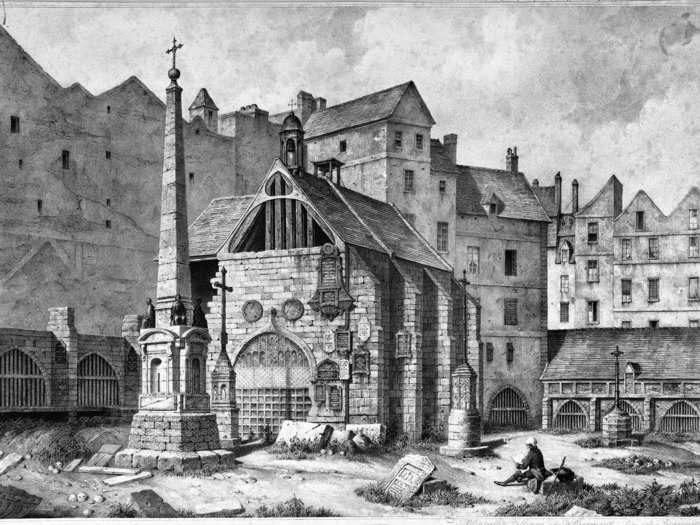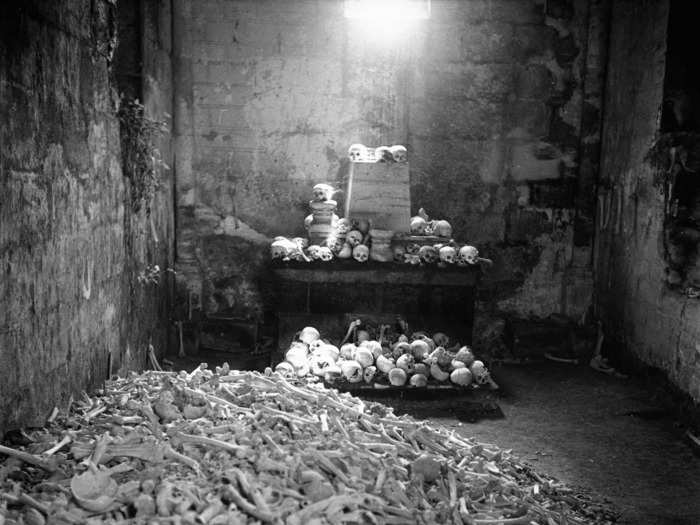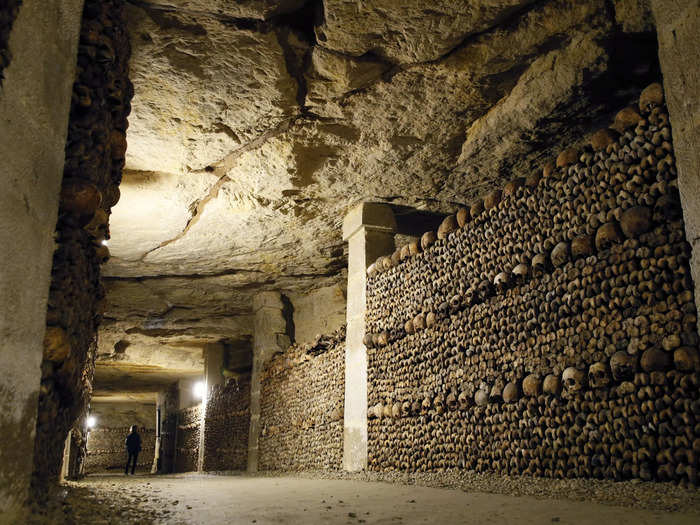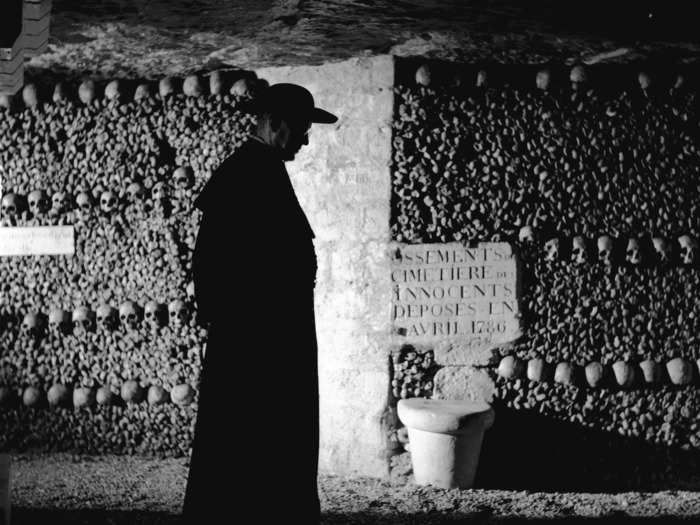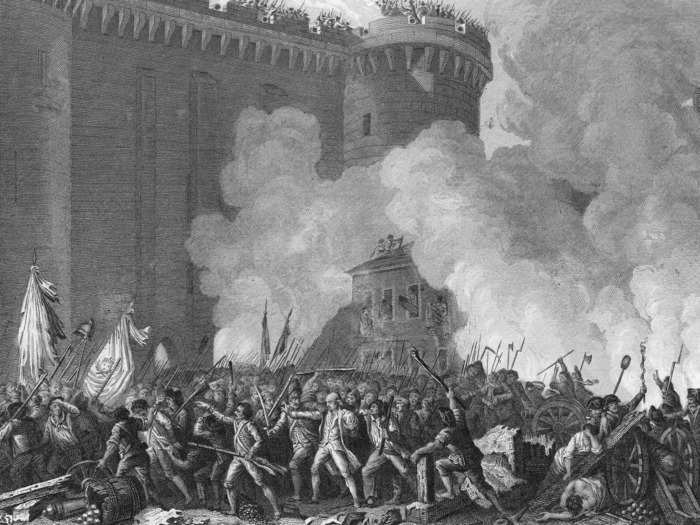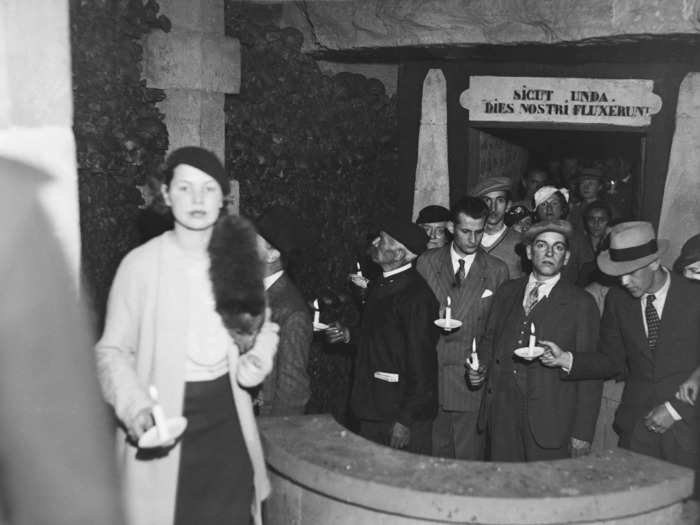A skull in crossbones is inlaid into a wall of bones.OLIVIER LABAN-MATTEI/Getty Images
- The Paris catacombs were constructed after mass gravesites started to pollute the soil and leech smells.
- The catacombs were originally the site of limestone mines used during the Roman Empire.
Mass graves had been in use for centuries in Paris, reaching a point where some graves held 1,500 bodies at a time. The smells and gasses were so bad that, in one instance, three gravediggers died from the gasses in a church vault.
Years of population boom, plagues, and wars overwhelmed Paris cemeteries. The Holy Innocents' Cemetery, in use since the 12th century, took the overflow from other cemeteries and surrounding hospitals, but it became too much.
When 100 feet of the street collapsed into an old limestone mine under Paris, Parisians had to find a new solution to address the overflow of dead bodies.
It all started with the Holy Innocents' Cemetery.
An engraving showing the mass graves at Holy Innocents' cemetery. Roger Viollet/Getty Images
Holy Innocents' was the oldest cemetery in Paris, thought to be in constant use since at least 1186.
Bodies from parishes with no cemeteries or parishes without space in existing cemeteries would end up in Holy Innocents'.
Then, in the middle of the 14th century, Holy Innocents' became the cemetery for Hôtel-Dieu, Paris' largest hospital at the time. Soon, the cemetery began to be filled with more bodies than it could handle.
Holy Innocents' became a mass grave site with pits holding up to 1,500 bodies at a time.
A figure of death walking with an upside-down baby. Sepia Times/Getty Images
After the plagues of the 14th century and the Hundred Year War in the 15th century, more bodies were added to the mass graves of Holy Innocents'.
The smell of decomposing bodies was so strong that a local perfume shop reportedly said the stench prevented them from selling products.
In some accounts from local inspectors, the putrid air changed the colors of tapestries, rotted meat, and turned buried barrels of wine into vinegar.
Eventually, the mass of bodies became too much and started spilling into the surrounding neighborhood.
Men talk amongst the piles of bones in the Catacombs. Universal History Archive/Getty Images
In 1780, a restaurant owner went to go get wine from his cellar when he was overwhelmed with a strong, putrid smell.
Upon searching for the source of the smell, he found that the wall in his cellar had burst and had filled his cellar with rotting bodies.
Burials at Holy Innocents' were halted, and the city had to find a new way to handle the corpses.
A drawing of the chapel at Holy Innocents' cemetery. Roger Viollet/Getty Images
Six years prior, 100 feet of the street collapsed into old Roman mines in Paris. The ancient Roman quarries, used to mine limestone, were chosen as a place to put the dead.
The solution became the Paris Municipal Ossuary, popularly known as the catacombs.
Piles of bones in a section of the Paris catacombs. Roger Viollet/Getty Images
The city began the process of moving millions of bodies from graveyards around Paris in 1786.
Rows of skulls and bones line the walls of Paris' catacombs. PATRICK KOVARIK/Getty Images
It took 12 years to move all the bones from between 6 to 7 million bodies.
A man walking along a hallway of bones. Vagn Hansen/Getty Images.
The clearing of bodies from their original graves resulted in a morbid side business. Because the bodies were not properly buried, the remaining body tissue and organs turned into "corpse wax" that was later turned into candles and sold.
Originally, the bones in the catacombs were thrown into unorganized piles because of the overwhelming amount of bodies.
Inspector Louis-Étienne Héricart de Thury is responsible for organizing the bones into the iconic shapes they take today.
A man walks through the Paris catacombs passing by inlays made of bones. Print Collector/Getty Images
Before the catacombs were open to the public in 1809, Inspector Héricart de Thury was tasked with re-arranging them into what they are today.
He added alters, plaques, and quotations invoking reflections on death.
During the French Revolution, bodies were buried directly in the catacombs.
Engraving of the mass attack on the Bastille fortress, igniting the French Revolution, Paris, France, July 14, 1789 Kean Collection/Getty Images
Several famous and infamous figures are buried in the catacombs, like Jean-Paul Marat and Maximilien de Robespierre, two influential voices during the French Revolution.
The practice of adding bones to the catacombs stopped in 1860.
Despite its sprawling 2,000 acres, only 1.25 miles are open to the public.
People gather in the catacombs holding candles for light. Keystone-France/Getty Images

